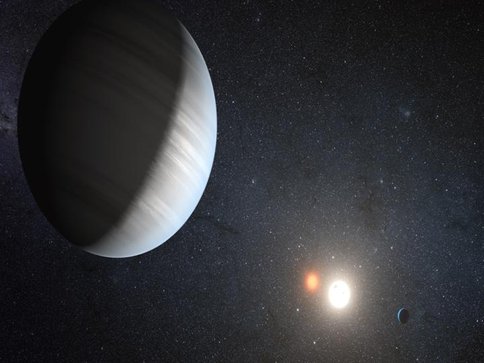2012 Annual Science Report
 University of Hawaii, Manoa
Reporting | SEP 2011 – AUG 2012
University of Hawaii, Manoa
Reporting | SEP 2011 – AUG 2012
Detection of Circumbinary Planets Using Kepler Space Telescope
Project Summary
Observations of stars in our galaxy have indicated that more than 60% of stars are in binaries or clusters. Several of these binary systems have been found to host circumbinary debris disks, suggesting that planet formation may proceed successfully around the entire binary system. During the past year, the PI teamed up with the Kepler Science Team to look for circumbinary planets. Their search has resulted in the discovery of three of such planets in 2012.
Project Progress
In close eclipsing binaries, measurements of the variations in a binary’s eclipse timing can be used to detect circumbinary planets (CBPs). This was demonstrated by the discovery of the first circumbinary planet, Kepler 16b in 2011, and subsequently by two other such bodies, Kepler 34b and 35b in 2012. For the past few years, the PI had been involved in developing theoretical models for the detection of CBPs. Earlier this year, the PI joined the team of the scientists of the Kepler space telescope to search for these objects in particular in the circumbinary habitable zone. In July and August 2012 the team announced the discovery of three more CBPs, including the detection of the first circumbinary planetary system (Kepler 47 b and c). The farther planet of this system (planet c) is in the binary’s habitable zone. The PI is continuing his collaboration with Kepler and is developing models that allow for the precise calculation of the location and range of circumprimary and circumbinary habitable zones in and around binary star systems.
Artist rendering of the two planets orbiting the binary star Kepler 47
Publications
-
Goździewski, K., Nasiroglu, I., Słowikowska, A., Beuermann, K., Kanbach, G., Gauza, B., … Rau, A. (2012). On the HU Aquarii planetary system hypothesis. Monthly Notices of the Royal Astronomical Society, 425(2), 930–949. doi:10.1111/j.1365-2966.2012.21341.x
-
Hinse, T. C., Goździewski, K., Lee, J. W., Haghighipour, N., & Lee, C-U. (2012). THE PROPOSED QUADRUPLE SYSTEM SZ HERCULIS: REVISED LITE MODEL AND ORBITAL STABILITY STUDY. The Astronomical Journal, 144(2), 34. doi:10.1088/0004-6256/144/2/34
-
Hinse, T. C., Lee, J. W., Goździewski, K., Haghighipour, N., Lee, C-U., & Scullion, E. M. (2012). New light-travel time models and orbital stability study of the proposed planetary system HU Aquarii. Monthly Notices of the Royal Astronomical Society, 420(4), 3609–3620. doi:10.1111/j.1365-2966.2011.20283.x
-
Orosz, J. A., Welsh, W. F., Carter, J. A., Brugamyer, E., Buchhave, L. A., Cochran, W. D., … Wade, R. A. (2012). THE NEPTUNE-SIZED CIRCUMBINARY PLANET KEPLER-38b. The Astrophysical Journal, 758(2), 87. doi:10.1088/0004-637x/758/2/87
-
Orosz, J. A., Welsh, W. F., Carter, J. A., Fabrycky, D. C., Cochran, W. D., Endl, M., … Borucki, W. J. (2012). Kepler-47: A Transiting Circumbinary Multiplanet System. Science, 337(6101), 1511–1514. doi:10.1126/science.1228380
-
PROJECT INVESTIGATORS:
-
PROJECT MEMBERS:
Eric Ford
Co-Investigator
Nader Haghighipour
Co-Investigator
Jerome Orosz
Co-Investigator
William Welsh
Co-Investigator
-
RELATED OBJECTIVES:
Objective 1.1
Formation and evolution of habitable planets.
Objective 1.2
Indirect and direct astronomical observations of extrasolar habitable planets.
